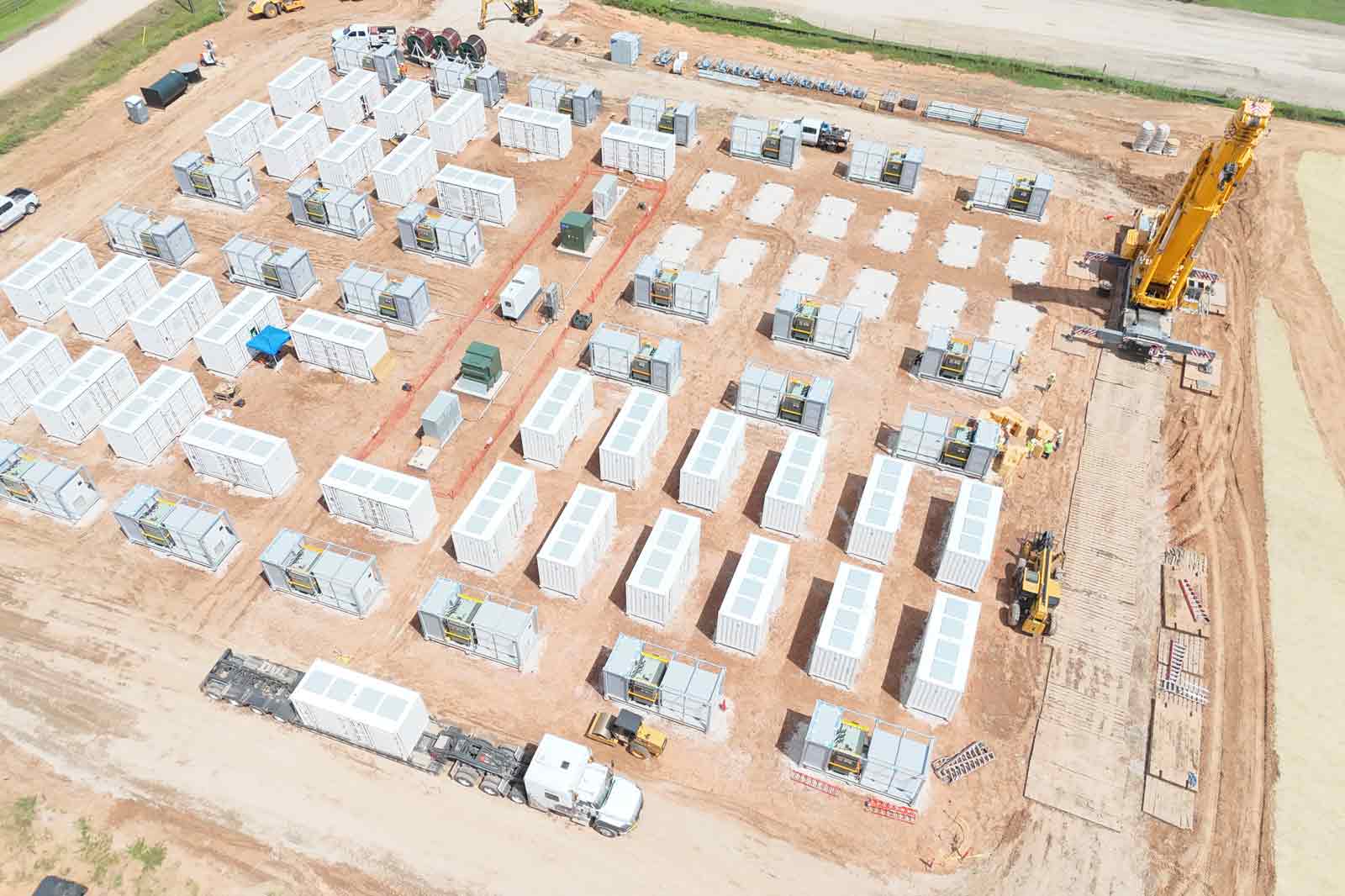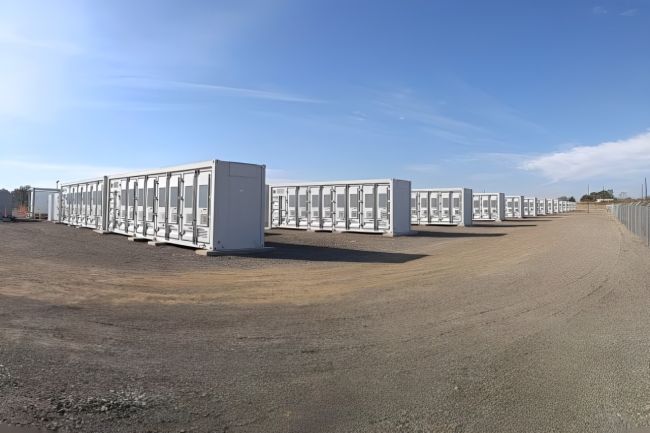Battery energy storage systems (BESS) are taking off in the U.S., adding much needed stability to aging electricity grids as more intermittent renewables go online.
RWE Clean Energy is among the companies powering up BESS projects across the U.S. With the recent construction start of Crowned Heron 1, Crowned Heron 2 and Cartwheel BESS projects in Texas, the company aims to add a combined power capacity of 450 megawatts (MW) in the state to support the ERCOT grid. The trio of projects pushed RWE passed 900 MW of battery storage projects under construction in the U.S.
 Construction is underway at RWE’s Crowned Heron 1, Crowned Heron 2 and Cartwheel battery storage systems in Texas. Commissioning is planned for 2025. (Source: RWE Clean Energy)
Construction is underway at RWE’s Crowned Heron 1, Crowned Heron 2 and Cartwheel battery storage systems in Texas. Commissioning is planned for 2025. (Source: RWE Clean Energy)
“I think we’ll probably hit the 1-gigawatt [GW] mark here in the coming six months or so,” Hanson Wood, senior vice president of utility-scale development for RWE, told Hart Energy. “We’re building several projects in both Texas and California. We have a lot in the pipeline, and we see storage as one of the fastest-growing technologies in this space. So, we’re really excited to put out these projects.”
The projects are taking shape amid U.S. ambitions to create a carbon pollution power sector by 2035. Energy storage is considered critical in making that happen, storing excess renewable energy during times of peak production and releasing it when generation is low.
 Hanson Wood. (Source: LinkedIn)
Hanson Wood. (Source: LinkedIn)
Data from the U.S. Energy Information Administration show utility-scale battery power capacity climbed to 20.7 GW in July. At the time, operators had added 5 GW of capacity to the U.S. power grid.
Batteries are the fastest-growing secondary electricity source for the grid, according to the EIA. Developers are forecasted to add another 15 GW of utility-scale battery capacity in 2024 and about 9 GW in 2025.
The growth also comes amid an anticipated surge in electricity demand, spurred by rising power needs for data centers, industrial processes and a manufacturing boom. Energy storage will be part of that growth story.
“The real narrative about storage is about reliability. It’s domestic jobs, and it’s creating a reliable grid through the energy transition,” Wood said. “That’s kind of undersold, in my opinion, for what the energy storage growing business is. … It’s been nascent but it’s actually going to be the connective tissue that allows the energy transition to be successful, and [it] also allows for a lot of people to win with jobs and manufacturing.”
Wood recently spoke with Hart Energy, giving insight on the energy storage sector and RWE’s growth plans.
Velda Addison, senior energy transition editor, Hart Energy (VA): What is enabling or driving RWE’s growth in this segment?
Hanson Wood, senior vice president of utility-scale development, RWE (HW): Storage is the fastest growing technology between now and 2030 in the energy space, in my opinion. I think storage has been held back over the last decade by not having the right regulatory framework. The IRA [Inflation Reduction Act] allowed for storage projects to directly claim the ITC [investment tax credit], and that’s allowing for letting storage projects to go forward in earnest on their own, not necessarily having to be paired with solar. But the conditions for storage is clear and that really comes down to highly favorable demand. It’s a technology that’s increasing grid reliability and that’s super important right now. It’s reinforcing our grid, which is really important. And I think for investors, it actually is one of the higher yielding return technologies in this space. And so, while we won’t do storage exclusively, we typically see favorable returns on those projects, highly favorable returns on those projects.
VA: Which regions do you see capacity climbing in the near term, let’s say, over the next five years or so and why?
HW: I think storage is going to expand across the U.S. into new markets like the Pacific Northwest, the desert Southwest like Arizona and Nevada and to the Southeast, New England, New York. Historically, storage has been focused on California and Texas and then a couple of projects here and there. But where renewables grow, storage will grow, and where grid additions need to be reinforced, storage will also grow to create a more resilient grid.
VA: What are some of the factors that could impact the pace of that growth?
HW: We’re obviously in an electoral season. So, I think new rules or regulations concerning the siting or development of storage would be something to watch out for. That’s something that would hold back storage. The interconnection queues being highly congested and having too many speculative projects would create some level of slow growth and then the permitting cycles. … Storage has a really great story. It’s a very small footprint. It can be located very hyper locally, which is great. We just need to help educate some of the local jurisdictions; the same batteries that are in your phone are the ones that we’re putting in the parking lot down the street.
VA: What trends, if any, are you seeing develop in the sector? Are you seeing projects get bigger, use different technologies?
HW: I definitely see a lot more storage, which is great. I definitely see getting above the handful of 500-MW projects. I see us having in the industry projects by the end of the decade maybe get up to a gigawatt. So that will be exciting. … We’ve already heard announced $60 billion of domestic manufacturing across all parts of rural America, largely the Southeast and Midwest. So, a lot of great jobs, not just from the construction but also from the manufacturing and logistics side of the business. That will be really exciting. I expect the technology to improve in terms of cost reduction as well as roundtrip efficiency in the technology. I think overall, we’re not at the beginning, but we haven’t hit our optimized stage of efficiency yet either. So, a lot of value gain across the board that I think we’ll see across, you know, several areas of beneficiaries-whether it be local communities getting lots of property taxes, whether it be lots of jobs through manufacturing, whether it be the technology getting cheaper over time and more efficient.
VA: Lithium-ion batteries have pretty much dominated utility-scale energy storage systems, but technology continues to evolve. What promising technologies are you seeing out there and do you think any of those might take off?
HW: I encourage you to think about this question in the form of a use case. Most storage has been deployed on [an] either two-hour or four-hour basis, and on that basis, lithium-ion will continue to dominate. Now, I think what our grid will need, and we’re seeing this in certain markets like California and in Arizona, is we’re seeing customers say they want something closer to 8 [hour]- to 10 [hour]- to 12-hour application. And that’s where a variety of technologies could end up evolving. And so, we would see flow batteries come in in that case. Just like we don’t think the energy transition is about one technology—solar or wind, gas, storage. It’s a hybridization of all those technologies trying to create a reliable grid … So is storage. It’s not going to be super short duration. It’s not going to be four-hour duration. It’s going to be a spectrum of all of that. I think that’s what we’ll see when we get to 2030. We’ll see every major RTO [regional transmission organization] will begin looking to integrate a diversity of duration, and that will lead to a diversity of technologies.
VA: Do you see more hydrogen storage projects on the horizon by 2030?
HW: I’m watching. I think hydrogen will be hyper regional, and that’s because hydrogen has a lot of complexity. It requires significant access to water. It requires access to pipeline distribution. And that is not ubiquitous the same way that the electric grid is with storage. The electric grid and batteries just plugging in anywhere that there’s a line overhead allows batteries to come in easily. I think hydrogen’s complexity between needing large areas for storage, distribution and water mean that it will probably play out first in the Gulf regions and then maybe Southern California. And then we’ll see where it can expand cost effectively given the distribution challenges.
VA: What’s next on the horizon for RWE when it comes to energy storage? Are [there] anymore big projects coming online this year?
HW: We have a very large pipeline of storage projects. … We have a 42-GW pipeline of solar, wind and storage projects, and probably a quarter of that is standalone storage. What you’ll see is that RWE will be building storage projects at large scale and paired with our solar projects across all of the U.S. So that will be California, ERCOT/Texas, SERC, MISO, PJM. We’ll be trying to deploy storage with solar almost everywhere … We have projects planned in California and Texas, and new markets will be Arizona, the Pacific Northwest, Nevada. We have a large pipeline in MISO and PJM as well. In some of those markets, we’re waiting for the customers to express demand directly. In other markets, we have offtake and we’ll be happy to share those projects when they’re ready go live on them.
